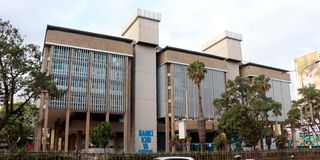Banks in rare profit drop as loan defaults hit Sh611bn

The Central Bank of Kenya, Nairobi.
What you need to know:
- The only recent years in which the sector returned a profit drop was in 2017 on the impact of interest rate capping law and in 2020 when Covid-19 disrupted businesses.
- Central Bank governor Kamau Thugge had, in June, linked part of the loan defaults to the prevailing tight economic conditions.
Banks posted a decline in combined profits in the first eight months of trading as loan defaults rose to a record Sh611.4 billion, reflecting the economic hardships that have gripped borrowers.
Latest data from the Central Bank of Kenya (CBK) shows the eight-month pre-tax profit dropped to Sh162.3 billion from Sh163.3 billion, marking a rare occurrence for the industry that has generally been enjoying profit growth.
The Sh1 billion decline or 0.6 per cent drop in profit contrasts a similar period last year when pre-tax earnings jumped by 28 per cent from Sh127.8 billion.
The only recent years in which the sector returned a profit drop was in 2017 on the impact of interest rate capping law and in 2020 when Covid-19 disrupted businesses. On both occasions, they rebounded within a year.
The CBK data shows gross non-performing loans (NPLs)— the amount of loans on which interest and principal have not been paid for at least three months— hit Sh611.4 billion in August, marking a Sh25.2 billion jump from the previous month.
The August figure means that the stock of NPLs has risen by Sh123.7 billion or 25.4 per cent since January — a development that has spooked banks, forcing them to increase provisioning for loan defaults.
Loan defaults
The Sh611.4 billion defaults against a loan book of Sh4.064 trillion at the end of August means the NPL ratio is at 15 per cent — being closer to the NPL ratio of 15.4 per cent that the sector posted 16 years ago in June 2007.
CBK said last month that increases in NPLs had been noted in the manufacturing, mining and quarrying, real estate, and building and construction sectors.
Factors such as the elevated price of goods and services, new statutory deductions such as housing levy, and increased interest rates in line with a higher Central Bank Rate (CBR)—now at 10.5 per cent, the highest point in nearly seven years—have combined to weaken borrowers' ability to service loans.
Central Bank governor Kamau Thugge had, in June, linked part of the loan defaults to the prevailing tight economic conditions and the many individuals and businesses awaiting payments from national and county governments.
Blow to borrowers
The CBK Monetary Policy Committee (MPC) will meet next Tuesday (December 5). The meeting could serve as another blow to borrowers should the committee choose to raise the CBR rate.
The last upward review of CBR was in June. The committee in October held the rate at 10.5 per cent, noting that the impact of the tightening of monetary policy in June to anchor inflationary expectations was still transmitting in the economy.
Nine-month unaudited results from top banks have shown an upward trend in the size of money being set aside in anticipation of defaults, eating into the profitability.
Top banks such as KCB, Equity, and Co-operative Bank of Kenya have all had single-digit percentage growth in profits, with many of them witnessing a rise in the NPLs ratio.
The CBK credit survey for June on 39 banks showed that 42 per cent of the respondents expected NPLs to rise in the third quarter, while another 24 per cent predicted the levels to remain constant.
Personal and household, trade and transport, and communication topped the list of sectors where many of the banks expected NPLs to spike.





